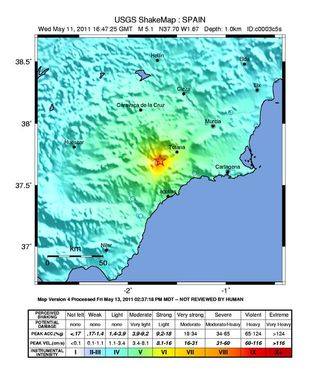
Deadly Spain Earthquake Triggered By Groundwater Removal

Groundwater removal triggered the unusually shallow and deadly earthquake that hit Lorca, Spain, in 2011, according to a new study.
Scientists have known for decades that pumping water into the Earth can set off small earthquakes. But this is the first time that removing water has been identified as an earthquake trigger, researchers said. Both the size and the location of the quake were influenced by groundwater pumping, the study found.
"The fact that the very tiny stress changes due to normal processes, such as the extraction of groundwater, could have an effect on very large systems such as faults, that's very surprising," said Pablo González, lead study author and a postdoctoral scholar at the University of Western Ontario in Canada.
The researchers were also able to precisely calculate the physical changes that generated the quake. The results will help seismologists better understand the physics that control when an earthquake starts and stops — an important step in predicting when and where a quake will occur, and its size.
"We need observations of this sort to calibrate physical models" of faults, said Jean-Philippe Avouac, a geologist at Caltech in Pasadena, Calif., who was not involved in the study. "The initiation and arrest of [fault] ruptures are something we are trying to constrain," he told OurAmazingPlanet.
Small quake, devastating effect
The May 5, 2011, earthquake was a relatively moderate magnitude 5.1. Quakes of this size usually don't cause significant damage in developed countries. A 2006 earthquake of magnitude 4.8 near Lorca did not cause any deaths. [Video: What Does Earthquake 'Magnitude' Mean?]
Sign up for the Live Science daily newsletter now
Get the world’s most fascinating discoveries delivered straight to your inbox.
But the 2011 quake ruptured only 0.6 miles (1 kilometer) below the Earth's surface, which meant the earthquake's energy was concentrated at the surface. Nine people were killed and dozens were injured, and both unreinforced masonry, like medieval churches, and modern buildings were damaged.
Thanks to previous research work in Spain, González suspected the quake's shallow epicenter could be related to groundwater extraction near Lorca. The groundwater table south of Lorca has dropped as much as 820 feet (250 meters) since 1960.
"When the tragic event occurred, we asked ourselves if the earthquake might be related to the subsidence. The earthquake was very shallow, and moreover, this pattern of subsidence was bounded by the fault," González told OurAmazingPlanet.
Linking subsidence to fault rupture
Using data from satellite imagery and GPS stations, González and his colleagues first confirmed the quake occurred on the Alhama de Murcia fault. Then, they calculated how the crust responded to removing the weight of the water. Releasing the load increased the stress on the Alhama de Murcia fault by a few tens of kilopascals — less than atmospheric pressure — the study found.
During the quake, the fault broke only in areas where removing groundwater increased stress on the fault. From this correlation, González inferred that the groundwater removal not only helped trigger the quake, but also controlled the size of the fault rupture and the earthquake's magnitude.
However, the amount of energy released by the quake far exceeded that built up by groundwater extraction. Thus, the earthquake released both stress caused by groundwater extraction and several centuries of regional deformation, the study concludes. Southeastern Spain is near the plate boundary region that separates the Eurasia and Africa tectonic plates.
The findings were detailed in the Oct. 21 issue of the journal Nature Geosciences.
This story was provided by OurAmazingPlanet, a sister site to LiveScience. Reach Becky Oskin at boskin@techmedianetwork.com. Follow her on Twitter @beckyoskin. Follow OurAmazingPlanet on Twitter @OAPlanet. We're also on Facebook and Google+.

